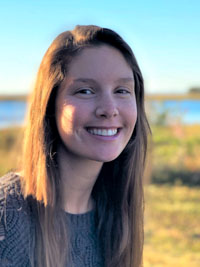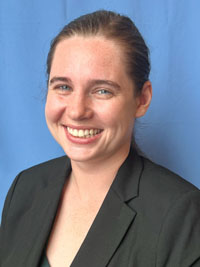2023 Impact Awards
Each year, The Graduate School honors graduate students in programs throughout our University for their powerful discoveries that contribute to a better future for people and communities in North Carolina. We’re pleased to present 11 Impact Awards for 2023 — and to share the honorees’ own descriptions of their research projects.

Predicting stroke risk using ultrasound technology
Keerthi S. Anand ‘18, Ph.D. candidate in biomedical engineering
“As one of the leading causes of death in North Carolina, ischemic strokes affect close to 300,000 North Carolinians and account for 5,700 annual deaths in our state. The primary causes are atherosclerotic plaques in the carotid artery that are vulnerable to rupturing and blocking flow to the brain. The risk of stroke doubles every decade past age 55, impacting about 30 percent of N.C.’s population. At-risk patients are screened using duplex ultrasound, which provides an image of flow velocity overlaid on a brightness map of tissue.
Carotid endarterectomies (CEA) are preventative surgeries to remove plaques, but the decision to perform these are determined by the percent flow restriction in the duplex ultrasound images. This metric neglects impacts of hazardous plaque components (lipid rich necrotic core and intraplaque hemorrhage) and the stresses on vessel walls associated with blood flow, which better confer stroke risk. In turn, most patients are predicted to undergo invasive CEA procedures unnecessarily.
My research involves developing a rapid, real-time realizable, and noninvasive method of ultrasound plaque imaging called Plane Wave-Variance of Acceleration (PW-VoA) that identifies vulnerable plaque components with high accuracy, while concurrently measuring multidimensional blood flow and dynamic stresses on the plaque surface. Through a faster, and more informative approach to evaluating atherosclerosis, we aim to better predict stroke risk and help reduce the number of invasive, and unneeded CEA surgeries performed in N.C.”

Who benefits from business attraction? Three essays
Adams Bailey, Ph.D. candidate in public policy
“Local and state governments use tools such as tax abatements, low-cost loans, and grants to lure companies to create jobs in their specific jurisdiction. Collectively referred to as economic development incentives (EDIs), these set of business attraction policies are perhaps the most ubiquitous and costly economic development tools used by the United States and its cities to facilitate growth.
While the relationship between incentives and local economic growth has been thoroughly examined, my three-paper dissertation examines how incentive policies and business attraction impact the welfare of residents and inequality within societies. Empirical papers examine how new jobs created through business attraction impacts unemployment rates and wages in communities and examine the how property prices react to EDI announcements—a key way in which EDIs can drive inequality through displacement and gentrification.
Finding that incentives have fewer than expected benefits for incumbent local workers but can drive up prices and costs of living, I argue that evaluations of EDIs should focus on the well-being of current residents and the equitable distribution of harms and benefits instead of centering solely on questions of whether incentives create growth. This work is relevant to U.S. state and local governments across the county, including in North Carolina, which look to formulate equitable development strategies that improve the well-being of their citizenry.”

Drivers of tidal creek accretion over the last century
Molly Bost ‘13 (‘16 MS; ‘22 Ph.D.), recent doctoral graduate in marine sciences
“The health of tidal creeks, which relies heavily on sediment dynamics, directly impacts the coastal communities that rely on commercial fisheries, tourism revenue, and protection from storms. My dissertation work supported a grass-roots concern among local fishermen in North Carolina, waterfront residents, and managers that tidal creeks are becoming shallower and more turbid, limiting their valuable ecosystem services.
To address this concern, I compared local watershed land-cover data for every decade since 1959 to sedimentation rates measured from sediment cores. I identified 12 tidal creeks, six in Carteret and six in New Hanover County, for this study that varied by order of magnitude in watershed area and relief, experienced different tidal ranges, and were impacted by different types of landscape change. My work provided a comprehensive record of accelerating sedimentation rates in creek beds following a land-use change but showed an opposite impact on the adjacent salt marshes over the past century.
These results revealed a disconnect between sedimentation in adjacent habitats which highlights the complexity of sediment dynamics in these important primary nursery habitats. My work will guide managers like the NC Department of Marine Fisheries who funded this research, to prioritize resources toward areas where sediment conservation or restoration is required to maintain the ecosystem function of tidal creeks and their salt marshes.”

Effects of the COVID-19 pandemic on access to fruits and vegetables for North Carolina WIC participants
Emily Duffy ‘12, (‘14 MS), Ph.D. candidate in nutrition
“My dissertation research aims to estimate the effects of a COVID-19 pandemic-related increase in the amount of money available for fruits and vegetables to mothers and children that participate in the Special Supplemental Nutrition Program for Women, Infants, and Children (WIC) among North Carolina (N.C.) WIC participants.
WIC is a federal nutrition assistance program that provides access to nutritious foods, health care referrals, and nutrition education to more than 220,000 low-income North Carolinians. WIC participants receive a monthly ‘food package’ which includes foods from specific, health-promoting food groups such as whole grains, lean proteins, and fruits and vegetables.
Prior to the pandemic, WIC participants received either $9 or $11/month/person for fruits and vegetables, an amount many nutrition experts have deemed insufficient. To counteract some of the negative effects of the pandemic on low-income families, in June of 2021, WIC increased the amount of money for fruits and vegetables to about $35/month/person, an unprecedented increase.
My research uses focus groups with N.C. WIC participants and food purchasing data from a large grocery store chain with almost 500 stores in N.C. to understand the effects of this policy change on N.C. families and their food access.”

Innovative approaches to triple-negative breast cancer cells
Emily Fennell ‘17 (‘22 Ph.D.), recent doctoral graduate in pharmacology
“Breast cancer is the leading cause of new cancer diagnoses in women. In North Carolina, ~10,500 women will be diagnosed with breast cancer in 2022. Nationally, triple-negative breast cancer (TNBC) accounts for ~10 percent of breast cancer diagnoses and is considered the most aggressive breast cancer subtype and is in need of more effective treatments. Recently, ONC201 was identified in a chemical screen as a promising new anticancer therapeutic. Despite a lack of information regarding its mechanism of action, ONC201 was moved into clinical trials for multiple cancers, including breast.
My research showed that related analogs (“TR compounds,” Madera Therapeutics, Chapel Hill, N.C.) had improved potency over ONC201 in preventing TNBC cell growth. Moreover, we demonstrated these compounds bind and activate the mitochondrial protease ClpP. I further showed ONC201/TR compounds induce mitochondrial dysfunction and significant loss of mitochondrial proteins required for energy and metabolite generation, respiration, and cell proliferation.
My current research has used “multi-omics” to detail the protein, mRNA, and metabolite-level changes occurring in TNBC cells following ONC201/TR compound treatment. From these studies, I hope to identify 1) mechanisms of growth inhibition caused by ClpP activation and 2) cancer-specific pathways that are significantly affected following ClpP activation. This information could be used to develop co-treatment regimens (existing anticancer drugs, nutritional interventions) to be used in combination with TR compounds to enhance therapeutic effects.”

On-site sanitation in North Carolina: Barriers to safe sanitation and associated adverse health outcomes
Amy Kryston, master’s degree student in public health
“The United Nations recently estimated that more than 5.75 million people in the United States lack access to safely managed sanitation. Those millions may be exposed to the effects of malfunctioning septic systems or straight piping, in which raw (i.e., untreated) sewage is piped directly from a household into nearby land or streams.
Almost half of North Carolinians use on-site sanitation systems, including septic systems or straight piping. Our research, funded by the Institute for the Environment and conducted with the Environmental Justice Action Research Clinic, seeks to address knowledge gaps regarding on-site sanitation, its social determinants, and the associated adverse health outcomes in marginalized North Carolina communities.
Our forthcoming literature review will provide the first comprehensive overview of barriers to safe sanitation throughout the U.S. and highlight how decision making and legal frameworks continue to systematically impede marginalized communities. Ongoing quantitative (spatiotemporal) work will highlight adverse health outcomes associated with malfunctioning or unsafe sanitation systems in North Carolina. Our qualitative research, including interviews with impacted populations, will give voice to the assets of and challenges faced by marginalized communities that may lack access to safe sanitation.
This research will provide data to communities and inform policy and funding decisions. It is of deepest importance to us that this research be guided by and, wherever possible, owned by communities so that they can advocate for their health and human rights, including safe sanitation.”

Produce distributed in urban and rural areas through the Food Bank of Central and Eastern North Carolina
Anna Naples, master’s degree student in public administration
“According to the U.S. Department of Agriculture, food insecure households not only do not have enough food, but they also consume less fruit and vegetables than those that are food secure. The Food Bank of Central and Eastern North Carolina (FBCENC) is one of the largest organizations in the state that intervenes in this problem, distributing millions of pounds of produce each year across 1,200 agencies in 34 counties.
My research study examined the difference between urban and rural counties, evaluating whether one type received a greater amount of produce per person under the poverty line over a six-month period. While each county’s status as urban or rural did not significantly correlate with the amount of produce it received, the data included other key findings. A significant number of agencies did not receive any produce, and many counties received a low amount of produce in proportion to the number of people under the poverty line.
With this data, I created a map in ArcGIS that shows how much produce was distributed to each agency, as well as county-level information. This map informs the organization of which areas should be their focus to increase equitable produce distribution. Specifically, they are using it for programs such as “pop-up” produce markets, partnerships with health care providers that connect patients to food pantries, and the mapping of chronic disease trends.”

How harmful cyanobacterial blooms affect air quality
Haley Plaas, Ph.D. student in environmental sciences and engineering
“As summers are getting hotter due to climate change, cyanobacteria, or blue-green algae, are thriving more readily in important North Carolina (N.C.) water resources. These bright green algae can produce toxins which cause serious and sometimes fatal illness in humans and animals. In addition to the obvious effects that blue-green algae have on water quality, recent research has shown that blue-green algae and their toxins can get into the air, posing previously unrecognized health issues.
As blue-green algae blooms expand across N.C., it is essential to gain a better understanding of the possible threats they pose to human respiratory health. My research is shedding new light on key blue-green algae compounds in the air and the weather conditions that promote their emission from N.C .waterbodies. Working with community scientists from Edenton, N.C., in summer 2020, we detected several strains of toxic blue-green algae in the airshed of the Chowan River-Albemarle Sound estuary.
For the first time, I demonstrated a link between blue-green algae activity in the water and increased atmospheric concentrations of PM2.5, an air pollutant regulated by the EPA per its ties to heart and lung disease. This study, with related research, has provided key stakeholders with the first and only information available on the impact of blue-green algae on air quality in N.C.”

Pediatric obesity among U.S. Latinos
Sophie Ravanbakht ‘13, Ph.D. candidate in health policy and management
“Rates of pediatric obesity continue to increase despite ongoing public health efforts to improve outcomes. According to the Robert Wood Johnson Foundation project, State of Childhood Obesity, North Carolina currently ranks tenth in U.S. states for highest rates of pediatric obesity, with 19.8 percent of children aged 10-17 having obesity. Furthermore, research shows that in the U.S., Latino children are more vulnerable to obesity than white and Asian children.
Acculturation, the process and effects of adjusting to a new culture after immigration, has been shown to be related to obesity in immigrants and their children. One theory is that as one acculturates, they engage in unhealthy diets and sedentary activity levels normative to U.S. culture, placing them at a greater risk for obesity. Children tend to acculturate faster than adults which results in the undertaking of additional responsibilities and stressors related to their roles assisting less acculturated family members.
My research explores acculturation and acculturation-related stressors associated with weight management for foreign-born Latino caregivers and their U.S.-born children, aged eight to 13 years old, attending a specialty weight management clinic in Durham, N.C. Understanding the impact of this clinic and the barriers to weight management for this unique population through qualitative interviews using systems science methods, my findings will help shed light on how clinical providers and policymakers can improve resources, guidance, and treatment of obesity in this vulnerable, growing N.C. population.”

How perfluoroalkyl substances (PFAS) contribute to platinum resistance in ovarian cancer
Brittany Rickard, Ph.D. candidate, in the curriculum toxicology and environmental medicine
“Compared to other gynecological tumors, patients with ovarian cancer suffer the highest mortality rates because tumors often become resistant to chemotherapy. Perfluoroalkyl substances (PFAS) are environmental contaminants that pollute drinking water supplies across North Carolina.
A recent study reported that PFAS increase ovarian cancer cell proliferation and induce resistance to platinum-based chemotherapy, the current standard of care for ovarian cancer. As a mechanistic basis for the observed resistance, mitochondrial health improved after exposure to PFAS, and mixtures, in human ovarian cancer cell lines. As a therapeutic approach to target mitochondrial health, PFAS-exposed cells were treated with photodynamic therapy (PDT), which uses a light-activatable molecule and visible light to cause cellular damage and to promote cell death. Reduced mitochondrial health and increased cell death were observed in ovarian cancer cells that were primed with PDT prior to chemotherapy. This demonstrates that PDT sensitizes PFAS-exposed ovarian cancer cells to chemotherapy and overcomes resistance to platinum-based chemotherapeutics.
This research will continue to highlight the importance of understanding environmental exposures when considering cancer treatment approaches. This is particularly relevant for North Carolinians, as communities along the entire Cape Fear River Basin are hotspots for PFAS pollution. Findings from this work support blood PFAS testing in ovarian cancer patients to identify those likely to fail on chemotherapy and the clinical integration of PDT for appropriate patient populations.”

Gestational exposure to coal-fired power plant-related air pollution and adverse birth outcomes
Adrien Wilkie (‘17 MSPH; ‘21 Ph.D.), recent doctoral graduate in epidemiology
“Coal-fired power plants (CFPP) are major contributors of ambient sulfur dioxide (SO2) air pollution. Epidemiological literature suggests an adverse association between gestational SO2 exposure and preterm birth (PTB). PTB is strongly associated with infant mortality and increased risk for later life morbidities. North Carolina (N.C.) depends on coal combustion for electricity. To address a 2002 N.C. policy, 14 of the largest N.C. CFPPs either installed desulfurization equipment (scrubbers) or retired coal units, resulting in substantial reductions of SO2 air emissions.
My dissertation 1) characterized N.C.’s electricity generation profile from 2000-2019, 2) investigated whether SO2 air emission reduction strategies at N.C. CFPPs were associated with changes in prevalence of PTB in nearby communities, and 3) evaluated associations between gestational SO2 exposures and PTB in N.C. Despite the stark drop in reliance on CFPPs for energy in N.C., and subsequent drop in emissions, CFPPs contribute ~60 percent of SO2 air pollution as of 2017.
These findings suggest a reduction of PTB among residents 4 to 10 miles of CFPPs that installed scrubbers compared to those living 10 to 15 miles. Additionally, we observed adverse associations between gestational SO2 exposures and PTB, with some evidence of effect measure modification by race/ethnicity. The U.S. and many other countries are making important decisions regarding the move away from or reinvestment in coal for electricity generation; research that considers the climate and health impacts of CFPPs can inform such decisions.”
